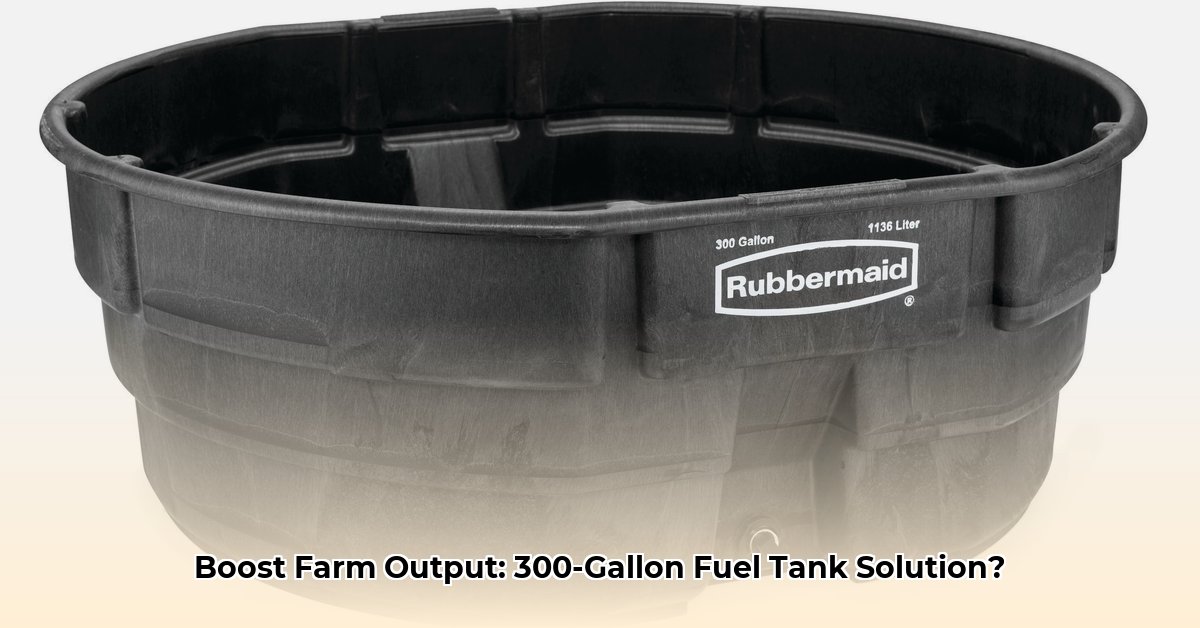
300 Gallon Fuel Tank Tractor Supply: A Comprehensive Guide for Sustainable Farming
Running a successful farm requires careful management of resources, and fuel is a critical component. Reliable fuel storage is essential for smooth operations and minimizing downtime. This guide explores Tractor Supply's 300-gallon fuel tank, examining its features, installation, maintenance, and its role in sustainable agricultural practices. We'll also compare it to other options to help you determine the best fit for your farm. For information on improving tire lifespan, check out this resource on tire inflation.
Assessing Your Fuel Needs: A Critical First Step
Before selecting a fuel storage tank, accurately assess your fuel consumption. How much fuel do you use weekly, monthly, and annually? Do you experience peak seasons with significantly higher fuel demand? Understanding your consumption patterns helps determine the optimal tank size, preventing overspending on excessive capacity or the inconvenience of frequent refills. Is a 300-gallon tank the right size for your operation, or would a smaller or larger tank be more appropriate?
The Tractor Supply 300-Gallon Fuel Tank: A Detailed Examination
Tractor Supply's 300-gallon fuel tank offers a balance of capacity and practicality, making it a popular choice among farmers. Let's delve into its key features:
Product Specifications:
- Capacity: 300 gallons
- Material: [Specify Material – e.g., Steel or Polyethylene. Obtain from Tractor Supply website] (Steel tanks are more durable but heavier; polyethylene tanks are lighter but may be less robust.)
- Dimensions: [Obtain dimensions from Tractor Supply website] (Ensure adequate space for placement and accessibility.)
- Safety Features: [List safety features from Tractor Supply website – e.g., Overfill protection, leak-proof seals] (Safety is paramount; these features mitigate risks.)
- Warranty: [Obtain warranty information from Tractor Supply website] (Understanding the warranty provides peace of mind.)
Installation and Safe Operation: A Step-by-Step Guide
Installing a 300-gallon fuel tank requires careful planning and execution to ensure safety and longevity. Follow these steps:
- Site Selection: Choose a level, well-drained location at least 50 feet from buildings and ignition sources. Avoid areas prone to flooding. (Proper site selection minimizes environmental risks.)
- Ground Preparation: Create a solid, level base using compacted gravel or soil. This prevents settling and tank damage. (A stable base ensures the tank's structural integrity.)
- Tank Placement and Securement: Position the tank according to manufacturer instructions, ensuring easy access for filling and inspection. Secure the tank to prevent movement. (Secure placement minimizes the risk of tipping or shifting.)
- Fuel Line Connections: Connect fuel lines securely, using the appropriate fittings. Ensure leak-free connections. (Proper connections prevent fuel spills and environmental contamination.)
- Initial Inspection: Before use, carefully inspect all connections and seals for leaks. (Proactive leak detection prevents accidents and environmental damage.)
Tank Maintenance and Care: Extending Lifespan and Preventing Issues
Regular maintenance is crucial for the longevity and safety of your fuel tank. A well-maintained tank reduces environmental risks and avoids costly repairs.
- Regular Inspection: Inspect the tank for leaks, corrosion, or damage at least monthly. (Early detection of problems prevents escalation.)
- Cleaning: Clean the exterior of the tank regularly to remove dirt and debris, preventing corrosion. (Cleanliness prevents premature corrosion and extends tank life.)
- Leak Detection: Check all connections and seals regularly. Repair any leaks promptly using appropriate sealant or replacement parts. (Promptly addressing leaks minimizes environmental impact and prevents accidents.)
Comparing Fuel Tank Options: Balancing Cost and Capacity
Several fuel tank options are available, each with strengths and weaknesses. The right choice depends on your specific farm needs and budget.
| Tank Size (Gallons) | Material | Pros | Cons | Approximate Cost | Sustainability Considerations |
|---|---|---|---|---|---|
| 150 | Polyethylene | Lightweight, less expensive upfront | Smaller capacity, frequent refills | $XXX | Less durable, potential for leaks |
| 300 | Steel/Polyethylene | Larger capacity, fewer refills | More expensive upfront, larger footprint | $YYY | Durable, but disposal is important |
| 500 | Steel | Largest capacity, infrequent refills | Most expensive, heavy, requires substantial space | $ZZZ | Highly durable, but requires responsible disposal |
(Note: Prices are estimates. Contact your local Tractor Supply for current pricing.)
Sustainability and Environmental Responsibility
Investing in a quality fuel storage tank contributes to sustainable farming practices. Reduced fuel waste through proper storage minimizes expenses and environmental impact. Choose a durable tank to minimize the need for frequent replacements. Responsible disposal of old tanks prevents environmental contamination.
Conclusion: Choosing the Right Fuel Storage Solution
Choosing a fuel storage tank is a critical decision. This guide provided a detailed look at Tractor Supply's 300-gallon option, highlighting its features and advantages. By carefully assessing your fuel needs, comparing available options, and prioritizing safety and maintenance, you can select a fuel storage tank that optimizes your farm's efficiency and sustainability. Visit the Tractor Supply website 1 to explore their fuel tank options and find the perfect fit for your needs.